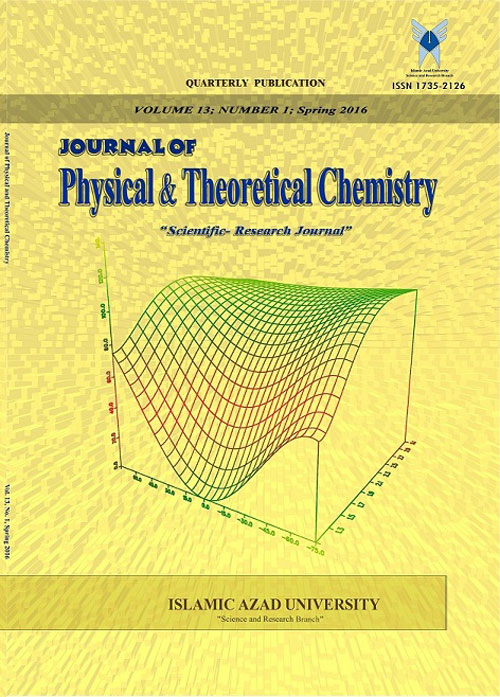فهرست مطالب

Journal of Physical and Theoretical Chemistry
Volume:2 Issue: 2, Summer 2005
- تاریخ انتشار: 1384/05/10
- تعداد عناوین: 7
-
Pages 3-7Phosalone, malathion and diazinon were analyzed in corn oil using solid phase extraction (SPE)with lanthanum silicate as a new solid sorbent followed by gas chromatography with nitrogenphosphorus detection (GC-NPD). The efficiency of different eluents (methanol, dichloromethane,ethyl acetate, dichloromethane — ethyl acetate (1:1) and ethyl acetate — methanol (1:1)) werecompared for elution of organo-phosphorus pesticides on lanthanum silicate-SPE in corn oil.Recoveries with methanol as eluent were 87% for phosalone, 95% for malathion and 69% fordiazinon with standard deviations of 5-14% in the concentration range of 0.5-2 mg kg-1. Thelimits of detection for these organophosphorus pesticides, were lower than maximum residuelimits (MRLs) established by WHO/FAO. Thin layer chromatography was performed using bedof lanthanum silicate ion exchanger to ensure the existence of the pesticides residue in the SPEextract.They were determined using gas chromatograph equipped with nitrogen phosphorusdetector.Keywords: Organophosphorus pesticides, SPE, Lanthanum silicate
-
Pages 9-20The interaction between proteins and membranes has an important role in biological pro-cesses.We have calculated energies of interaction between Melittin and DMPC bilayer in differenttemperatures. We have used the CHARMM software for MD simulation under the canonical (N,V, E) ensemble at different temperatures. The computations have shown that water moleculeshave more penetration into the bilayer around the transition temperature of DMPC bilayer.Phosalone, malathion and diazinon were analyzed in corn oil using solid phase extraction (SPE)with lanthanum silicate as a new solid sorbent followed by gas chromatography with nitrogen thedetectorKeywords: Melittin, DMPC bilayer, Temperature stability, Molecular dynamics simulation
-
Pages 21-27A new, simple, rapid, and cheap method for determination of trace amounts of nitrite ion is reported.Determination is based on reduction of bromate ion by nitrite ion, in the presence of murexide inacidic media. During reaction of bromate ion with nitrite ion, the reaction mixture is decolorized.The absorbance changes is then monitored spectrophotometricaly at 520 nm, at 25 °C. Dynamicrange of calibration curve for nitrite ion is in the range of 1-22 ig.mL 1 . The effect of interferingions was investigated. This method was successfully used for determinination of nitrite ionconcentration in sausages.Keywords: Kinetic-spectrophotometric determination, potasium bromate, murexide, nitrite ion
-
Pages 29-34In the present work, the interaction of three water soluble porphyrins, tetra (p-trimethyle) ammoniumphenyl porphyrin iodide (TAPP) as a cationic porphyrin, tetra sodium meso-tetrakis (p-sulphonatophenyle) porphyrin (TSPP) as an anionic porphyrin and manganese tetrakis (p-sulphonato phenyl)porphinato acetate (MnTSPP) as a metal porphyrin, with DNA have been studied by isothermaltitration microcalorimetry at 1 mM phosphate buffer, pH 7.0 and 25 °C. The values of bindingconstant, entropy, enthalpy and Gibbs free energy changes for binding of the first MnTSPP, and firstand second TSPP and TAPP molecules were estimated from microcalorimetric data analysis. Theresults represent that the process is both entropy and enthalpy driven and DNA induces selfaggregationof the porphyrins. The results indicate that both columbic and hydrophobic interactions actas self-aggregation driving forces for the formation of aggregates around DNA.Keywords: Porphyrin, DNA, Isothermal Titration Microcalorimetry, Aggregation
-
Pages 35-39The combination of Quantum Mechanics (QM) and Molecular Mechanics (MM) methods hasbecome alternative tool for many applications that pure QM and MM could not be suitable.The QM/MM method has been used for different type of problems, for example: structuralbiology, surface phenomena, and liquid phase. In this paper we have performed these methods forsome antibiotics and vitamins and then we compare results. The calculations have done by full abinitio method (HF/3-21g), (11F/6-31G) and (HF/STO-3G) and QM/MM (ONIOM) method withFIF (3-21G)/AM I /UFF IlF(6-31G)/AM I /UFF and HF (STO-3G)/AMI/UFF then we find out thegeometry that has obtained by QM/MM method is very accurate and we can use this rapid methodin place of time consuming ab initio methods for large molecule. The comparison of energyvalues in QM/MM and QM methods is given. In the present work we compare chemical shiftsand conclude that QM/MM method is a perturbed full QM method.
-
Pages 41-45The adsorption of pyrazolone(HPMSP), Calix[4]-arene,Cu and Cs, on carbon nanotube(CNT) atroom temperature has been investigated using spectroscopy.Uv spectroscopy indicated that pyrazolone molecules adsorbed on carbon nanotube at roomtemperature in compared calix[4]- arene molecules adsorbed approximately same.The amount ofpyrazolone(HPMSP) adsorb 3.8. le mol/g and amount calix[4]-arene adsorbed 1.3 x10-5mol/g.Thephysisorption of such an organic molecules is an example of nano covalent functionalization involvingrc-11 stacking interactions and corresponding to weak binding energy.The most favourable adsorptionsite is one type C-C bond. Atomic adsorption shown carbon nanotube has capability and a highadsorption efficiency for adsorption of Cu(II) and Cs from of water.Keywords: Pyrazolone(HPMSP), Calix(4)-arene, Cu(NO3)2, CsNO3, Carbon nanotube
-
Pages 47-56The formation constants of the species formed in the systems fr + glycine + dioxovanadium(V) + and H+ + glycine have been determined in aqueous solutions of methanol at 25 °C and constant ionicstrength, using spectrophotometric and potentiometric techniques. It was shown thatdioxovanadium(V) forms two mononuclear 1 : land 1:2 complexes with glycine. The formationconstants in various media were analyzed in terms of Kamlet and Taft's parameters. Single-parametercorrelation of the formation constants, 13 and 13122, versus a (hydrogen-bond donor acidity) and f3(hydrogen-bond accepter basicity) are poor in all solutions, except for le (dipolarity/polarizability), butmulti-parameter correlation represents significant improvement with regard to the single-parametermodels. Linear relationship are observed when logp and logf3 1,2 are plotted versus re. Finally, theresults are discussed in terms of the effect of solvent on complexation.

